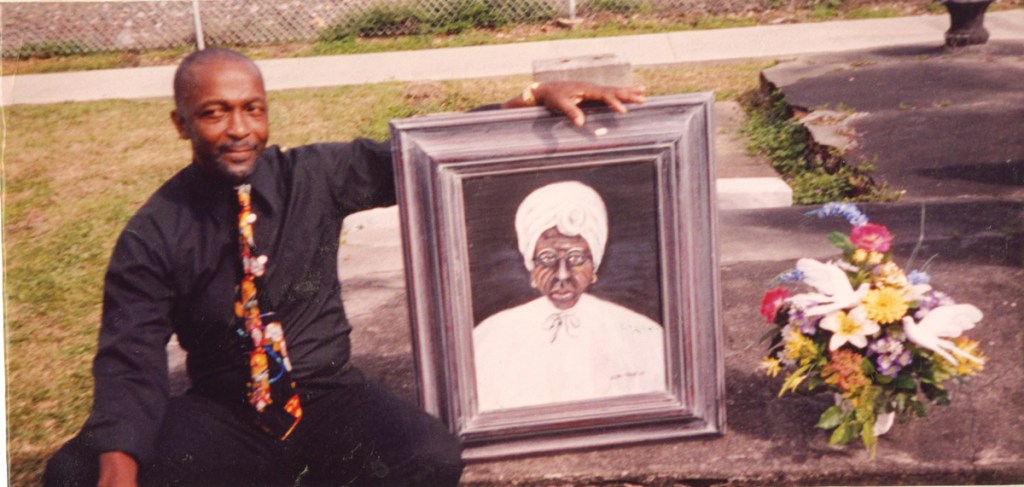Domestic dignitaries
Published 1:00 pm Monday, February 22, 2016

- Michael Bell, founder of the Felicité Humanitarian Society, poses with a portrait of his hero that was created by a Shreveport artist visiting during one of the public events organized by Bell to honor the former slave.
Contributions to community made by the unsung
Trending
Remembering people who have made significant contributions to history usually means repeating the well-known stories of individual triumphs later recognized as touching others lives.
So too are the local luminaries who touched lives of people who grew up to do great things of historic proportion, or perhaps, on a smaller scale.
Building a Legacy
Phebe Archon Hayes is a retired communication disorders professor from the University of Louisiana at Lafayette and former Dean of the College of General Studies. She has spent many hours in the genealogy archives of Iberia Parish searching her family history. She also volunteers to help others, especially black descendants, try to locate their family roots in a complex system of records only experienced researchers find more exciting than frustrating.
“I know my heritage down to the DNA,” Hayes said. “I found my three-times great-grandmother who came here with her husband and children as slaves from the Maximilien Decuir plantation in Point Coupee Parish. Three of my ancestral grandfathers fought as freed men, Union Soldiers, during the Civil War.”
She said her family members have always been hard workers believing in education and building a family legacy. They worked from sunup to sundown and saved their money to buy land, Hayes said. When they bought land, they worked even harder and longer hours to buy additional land and save for future generations. Some of the heirs still live on the property they purchased for raising sugar cane.
Trending
“I’m passionate about telling their stories for truth to reign,” Hayes said. “I’m so blessed to have had my people, grandparents and parents, tell stories, even if I wasn’t interested in them as a child. When I decided I wanted to learn more, the stories I remembered helped drive my research. I just want their voices to be heard.”
Aunt Kate
Through her research Hayes discovered another family line, written about by a descendant of the owners of her three-times great-aunt Catherine “Kate” Manuel Curtis after the Civil War. In Patricia Watters’ book of family memoirs, “Around the Belt,” it was noted “Kate, like many of my great-grandfather’s slaves, stayed on the plantation after they were freed, mainly because he treated them well.”
Hayes said she’s not sure if that was the reason people stayed on plantations or if it was for economic reasons. Her great-great-grandfather, Alphonse Manuel, was Kate’s brother. The stories they passed down through the family spoke of a woman so dearly loved, that toward the end of her life, generations of families, especially of men, traveled the well-worn path where Aunt Kate lived just to honor her. They shared a great love.
“My cousin who lived next door told me the children she (Aunt Kate) raised, as well as our family, would come park along the road and walk way back through the woods to visit and bring her gifts at Christmas and until she died.”
Hayes said she assumes the feelings between Aunt Kate and the families were genuine. Her story alone does not inspire Hayes to seek history of animosity between the races. Family stories on the opposite pole of Aunt Kate, however, simply said “living as a slave was hell.”
Those ancestors preferred to leave their life stories alone. Instead, these former slaves reared their families to be responsible, educated and contributors to community. Hayes said many blacks have done much to help build the community and few know anything about them.
“What inspires my work is to identify those people who were the big contributors in our community, who don’t have a memorial,” Hayes said.
“For example blacks like A.B. Simon, J.B. Livingston and Jonas Henderson. They educated children coming out of slavery,” she said. “Their monuments, if they had names on schools, have either been destroyed or never erected. Education is key to the future. The more we learn the more we find we’re all alike and there’s no room for hate.”
Character not Color
What separates the races is not the color of skin nearly as much as the character of heart, a sentiment expressed by Michael Bell, a distant relative of Hayes. Bell, also a native of Iberia Parish, said he thinks there should be a mandate to keep history alive. He said it “shall not be allowed to drop into oblivion,” the words that inspire him from the marker for, “Felicité,” placed outside New Iberia City Hall and the Iberia Parish Library on East Main Street.
Bell, along with Eula Williams and Debra Ann Mitchell, he described as “strong women who get the job done,” helped establish the Felicité Humanitarian Society in 2008, he said. Beginning in 2001 as a public ceremony to honor contemporaries who show the same compassion as Felicité, the nonprofit organization is dedicated to perpetuating her name and stories of her character.
Felicité
Felicité, a native of Haiti, was a former slave who was so beloved, “The day of her burial every business in New Iberia closed its doors. Every man, woman and child in town followed her to her last resting place,” the marker reads. She was laid to rest In St. Peter’s Cemetery at the foot of her former owner, Frederick H. Duperier, the man attributed to incorporating New Iberia.
Also born in Haiti, Duperier and his sister were sent to the United States by their parents during the slave uprisings in the late 18th century. At 10 or 12 years of age he arrived in New Iberia to stay with his Aunt Pintard. Inez Friend “Penny” Quereau White, a descendant of Duperier, said they weren’t sure if Felicité came with Duperier from Haiti or not, but the family stories clearly connect them.
“In the early 1800s, Pintard had an inn and grocery store where the convent sits,” White said. “She had no children so she took F.H. in and raised him. All we’ve been told was Felicité was his property.”
Before his death in 1839, it is believed that Duperier freed Felicité, White said. She continued to live with Mrs. Duperier at the convent until her death. It was during the next year the yellow fever epidemic severely hit the Teche Area. For 12 years the community experienced her compassion and healing services until she died in January 1852.
Felicité’s helper was another former slave named Old Joe, Bell said. Neither were forced to go into the woods to harvest roots and herbs to make poultices and tonics to treat the sick, learned from their culture as they had cared for their own without the aid of doctors.
They knew what needed to be done, Bell said. The two worked hand in hand to minister to the people of the Bayou Teche. Skin color was not their motivator, rather, the character of their heart, he said.
“My mother told me about Felicité and her mother told her about Felicité,” Bell said. “My mother would sing me a song that they would tell about things she did in this town. I made it my business to know what she did, and sure enough, she walked these streets and did remarkable work.”
Never before in the history of New Iberia, Bell said, did every man woman and child go to a former slaves’ graveside. Many dignitaries are buried at St. Peter Cemetery, so it seems fitting Felicité is, too. She was a slave physically early in life, but not mentally, Bell said.
Honoring Mammy
Bell’s parents would tell him stories about New Iberia’s past, but he said they never had hate.
“I saw the movie ‘Gone With the Wind’ and was ashamed of the role of Mammy,” Bell said. “My mother said, ‘Your mama was a mammy, my mother was a mammy and we’re a proud family. They didn’t have hate. There was great love between the white families and the domestics.”
Bell said his grandmother was the cook for Courrege family, who owners a local café, back in the 1920s and 1930s. Cora May Monday, his grandmother, was a super cook.
“ ‘You need to take that word Mammy and make it something because that word mammy is not an insult. It expresses kindness, love and compassion,’ ” Bell said his mother remarked. “Black people have a strong spiritual sense. It’s so important to me. I have seven grandchildren and I don’t teach them hate. I teach them love.”
It’s about their character, he said. The world is too corrupt and too dangerous to teach hate, Bell said, adding that he feels blessed to have been surrounded by parents and siblings who were taught to love one another.
“You can’t raise a child and teach them hate. All it’s going to do is complicate their lives,” Bell said. “I have a responsibility to teach Felicité. We’ve got to get a building or something named after someone who did so much. The yellow fever came in here on the Bayou Teche, not just to the black community but to everyone. Tourism that would tell her story, about the plantations and the descriptions of the people, all the cultures along the Bayou Teche. We have to have an open mind, for it to work.”
Families Intertwined
“My family names are Hopkins, Lourd, Duperier, Indest, Quereau and Knight,” said White. “My great-grandmother was named Felicité. She was a handmaiden on Marie Antoinette’s court. With her family she escaped to avoid the guillotine and ultimately her ancestors settled in the Teche Area.”
The Duperier graves and markers along the railroad tracks and even the bricks for the original St. Peter’s Church were made of mud from the Bayou Teche and built by slave labor, White said. Their work is still admired.
“It makes me very sad to see (today’s attitudes between the races). At one time we would have given our lives for them, and they would have given their lives for us,” White said. “Now they want to take our lives — goes both ways. The hate is unbelievable.”
Often it’s the nameless people who excel at ordinary jobs but accomplish extraordinary things are the ones who build nations and communities. And their families leave their mark for future generations.





